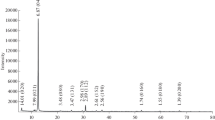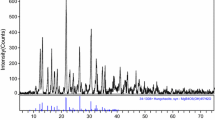Abstract
Natural brucite and two precipitated Mg(OH)2 samples were analysed in a simultaneous TG-DTG-DSC analyser. The initial dehydroxylation temperature of natural brucite is lower than those of the precipitated samples, but the maximum and final temperatures of the former are higher than those of the latter. The maximum temperatures of individual samples obtained from DTG and DSC curves are almost the same. Heats of reaction derived from peak areas for the three samples are not exactly the same, as they are influenced by the specific surface area of the individual sample. Activation energies deduced by Freeman and Carroll's method are very different from one another. This is attributed to the difference in pressure when the sample is crimped. A linear relationship is observed between the deduced activation energy and the specific height of the DSC peak.
Résumé
La brucite naturelle et deux échantillons de Mg(OH)2 précipités ont été étudiés par TG-TGD et DSC simultanées. La température initiale de la déshydroxylation de la brucite naturelle est plus faible que celle des deux échantillons précipités, mais les températures maximale et finale de déshydroxylation de la brucite sont plus élevées que celles des échantillons précipités. Les chaleurs de réaction déduites de l'aire des pics DSC des trois échantillons ne sont pas exactement les mêmes, puisqu'elles sont influencées par l'état de surface des échantillons individuels. Les énergies d'activation trouvées en appliquant la méthode de Freeman et Carroll sont très différentes les unes des autres. Elles sont attribuées à la différence de pression au niveau de l'échantillon. On a observé une relation linéaire entre l'énergie d'activation déduite et la hauteur spécifique du pic DSC.
Zusammenfassung
Natürlicher Brucit und zwei gefällte Mg(OH)2-Proben wurden in einem simultanen TG-DTG-DSC-Analysator geprüft. Die Anfangstemperatur der Dehydroxylierung des natürlichen Brucits ist niedriger als die der gefällten Proben, doch sind Maximal- und Endtemperaturen des ersteren höher als jene der letzteren. Die an Hand von DTG und DSC-Kurven erhaltenen Maximaltemperaturen der einzelnen Proben sind fast identisch. Die aus den Peakflächen der drei Proben errechneten Reaktionswärmen sind nicht genau dieselben, da sie von der spezifischen Peakfläche der einzelnen Proben beeinflußt werden. Die mittels der Methode von Freeman und Carroll abgeleiteten Aktivierungsenergien sind von einander sehr verschieden. Sie werden den Unterschieden im Druck bei dem Schrumpfen der Probe zugeschrieben. Ein linearer Zusammenhang zwischen der abgeleiteten Aktivierungsenergie und der spezifischen Höhe der DSC-Peaks wurde beobachtet.
Резюме
Природный бруцит и дв а образца осажденног о Mg(OH)2 были проанализиров аны с помощью одновремен ного ТГ-ДТГ-ДСК анализ атора. Первоначальная темп ература дегидроксилировани я природного бруцита ниже, чем осажденных образцов, но максималь-ная и кон ечная температуры дл я него выше, чем для последних. Максималь ные темпера-туры инди видуального образца, полученные из ДТГ и ДС К, почти одинаковые. Теп лоты реакции, установленн ые из площади пика, для этих трех образцов, не совсем од инаковые, так как они обусловле ны удельной площадью поверхности индивид уального образца. Энергии активации их, выведенные по методу Фримэна—Кэрролла, оч ень отличаются друг от друга, что обус ловлено различием в д авлении при обжимании образц а. Наблюда-ется линейн ая взаимосвязь между выведенной энергией активации и удельной высотой пика ДСК.
Similar content being viewed by others
References
D. T. Y. Chen, J. Thermal Anal., 6 (1974) 109; D. T. Y.Chen, ibid, 7 (1975) 61; D. T. Y.Chen and P. H.Fong, ibid, 8 (1975) 295; P. H.Fong and D. T. Y.Chen, ibid, 8 (1975) 305.
S. J.Gregg and R. I.Razouk, J. Chem. Soc., (1949) S36.
H. Kenya, Yogyo Kyokai Shi, 71 (1963) 61.
R. C. Turner, I. Hoffman andD. Chen, Can. J. Chem., 41 (1963) 243.
J. H. Sharp, Trans. J. Brit. Ceram. Soc., 73 (1973) 21.
G. Hashizume andK. Amita, Bunseki Kagaku, 19 (1970) 667.
B. S. Girgis, Trans. J. Brit. Ceram. Soc., 71 (1972) 177.
V. V. Pechkovskii, L. P. Lostin andA. G. Zvezdin, Sb. Nauchn. Tr. Pernisk. Politekhn. Inst., 10 (1961) 155.
A. P.Pirmatov and M. G.Altykis, Sb. Aspir. Rab., Kazan Gos. Univ., Khim., Geol., (1967) 64.
F. Freund andH. Geutsch, Ber. Deut. Keram. Ges., 44 (1967) 51; F.Freund and H.Naegerl, Therm. Anal. Proc. Int. Conf. 2nd, 2 (1968) 1207; H.Naegerl and F.Freund, J. Thermal Anal., 2 (1970) 387.
P. J. Anderson andR. F. Horlock, Trans. Faraday Soc., 58 (1962) 1993.
Author information
Authors and Affiliations
Additional information
The authors wish to thank Dr. T. C. W. Mak, Department of Chemistry, The Chinese University of Hong Kong, for taking the X-ray diffraction data.
Rights and permissions
About this article
Cite this article
Chen, D.T.Y., Fong, P.H. Thermal analysis of magnesium hydroxide. Journal of Thermal Analysis 12, 5–13 (1977). https://doi.org/10.1007/BF01909850
Received:
Revised:
Issue Date:
DOI: https://doi.org/10.1007/BF01909850




